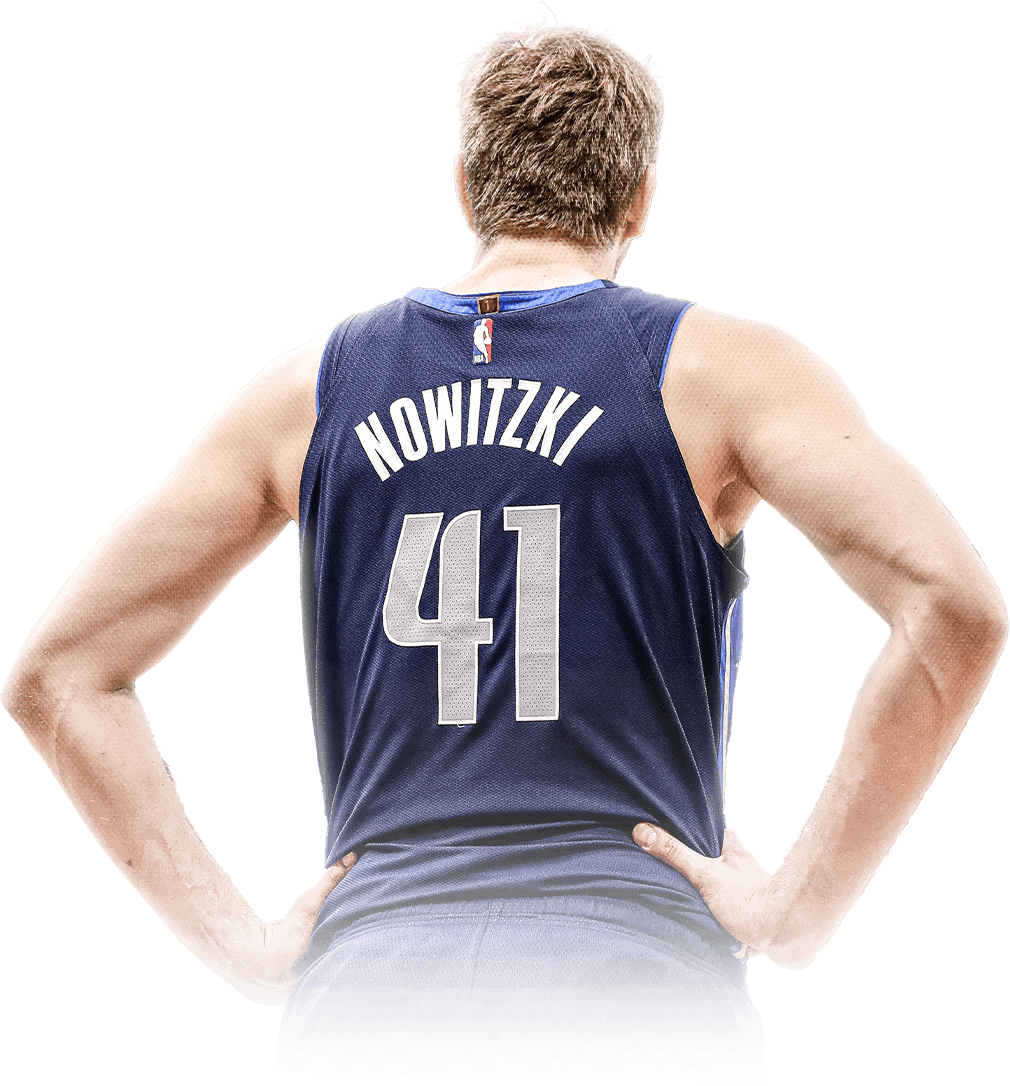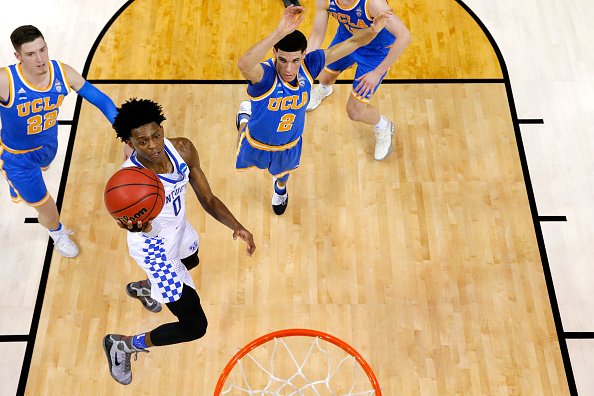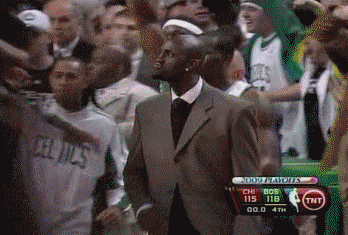SI.com escreveu:LAS VEGAS -- The desert heat changes everything here, so it's hard to tell whether Kawhi Leonard dripping sweat five minutes into his morning workout is truly a sign that he's grinding harder than the others.
But facts are facts, and the only difference between the guy in braids and the other half-dozen players on the floor is the lather that he has going and that they do not. The drill itself doesn't look all that taxing -- dribble drive from halfcourt to the elbow extended, where the body double for Rudy stands with a tackle pad and offers a gentle bump, then finish the play either at the rim or with a mid-range jumper. It's the up-and-back, full-court sprints in between turns where Leonard is spiking his heart rate.
The cardio element in the drill came courtesy of trainer Joe Abunassar, the guru at this Impact Basketball Academy who is often asked to take the already-solid game of NBA draft prospects to new heights in, oh, six or eight weeks. It's an insane concept, really, the idea that young men who have already decided that they are good enough to be professionals can elevate their stock by legitimately improving in less than the span of a summer.
But Leonard, the 6-foot-7 small forward out of San Diego State who decided to leave the Aztecs after his sophomore season back when he was slated as a mid to late first-round pick, has done just that. And when June 23 rolls around, the gritty work ethic for which he is known just might have helped him become a top-10 talent.
The release is higher and quicker on his shot now than it was in March, when he was at the forefront of San Diego State's historic Sweet 16 run and 34-3 record while leading the team in scoring (15.5 points per game) and rebounds (10.6). Thus, another red flag is put away by some NBA executives who wondered if there was limited potential to his outside game.
Leonard's shooting-guard skills have been refined, an absolute necessity considering his "tweener" status when it comes to size. His technique has improved on ball-screens, with the new Leonard coming off tighter and finding the airspace for a quality shot after so many years of the old Leonard going wide and wacky. This is subtle but significant stuff, and the coaches who boast more than 100 NBA clients as part of their "alumni" claim that Leonard's drive -- his "motor" as it's more commonly known -- still stands out among the rest.
"There's nobody who's more focused and more serious about what he's doing than Kawhi," Impact director of player development Andrew Moore said. "He's just a pure basketball guy. He loves shooting, loves working out, loves one-on-one, loves defending. He comes in every day and there's no sideshow, nothing else going on.
"[His motor] is more than I ever expected. As a training facility, the one thing we can't really teach is a motor, the want and desire. And he's off the charts. That's why he's been able to get so much better and make the necessary changes for the NBA that he had to in such a short time, because he has that fire, he has that motor."
That singular focus on the game is overwhelmingly evident during a day spent watching Leonard and picking his 19-year-old brain. Ask him about his story -- including the most publicized part of his tale, the tragic murder of his father three years ago -- and he obliges with polite responses but very little passion. Inquire about the hype that surrounds him and his rising stock in the draft, and he acts as if he couldn't find his way onto the Internet to read the latest chatter if he tried.
But give him an excuse to talk about this game, to break down the kind of player he is and what he wants to become, and the youngster from Moreno Valley, Calif. suddenly sounds like Steve Kerr on the latest TNT broadcast.
"Keeping my follow through on my shot is big right now, and the three-point shot -- quick release, catch and shoot, just having confidence, making sure the arc of my ball is straight, my release point is good, staying low coming off ball screens, running situations when players are open when you come off ball screens," he says while lying on a table and receiving treatment on the ankle that has been sore of late. "Just my overall game. I'm trying to just work on everything so I can fit right in with a team. That's the type of player I want to be, someone you can put on the floor and they do it all ... I'm just working on every part of my game, trying to be a great overall player. Basketball is basically my whole life."
It really is that simple now, even if it wasn't back on Jan. 19, 2008.
Until that day, the Compton car wash that was owned by Kawhi's father, 43-year-old Mark Leonard, was a cherished place for both him and his son. They spent weekend days there together, the kind of time that a young man with four older sisters needs when his parents aren't together and he lives with his mother. But a killer who has still not been found gunned Mark Leonard down that night, and a life that had been so smooth to that point was forever changed.
"The biggest tragedy was his dad," said Kim Robertson, the mother of Kawhi and two of his sisters who works as a sales agent for Amtrak. "Other than that, everything was fine. He never suffered, never needed anything. That was his biggest tragedy, and mine as well."
Yet any questions about how Leonard would handle it were answered the next day, when he decided to play in a game between his Riverside King team and Compton Dominguez. He scored 17 points in a loss, then -- according to reports at the time -- cried in his mother's arms just after the final buzzer sounded.
The feelings aren't so raw anymore, but the approach remains the same. Basketball is the emotional outlet, the focus, the reasons for his competitive fire.
"I'm thinking [that] he's come to grips with what has happened [to his father]," Robertson said. "This is reality. My dad is gone, but his memory is always going to be there. He's always going to be thinking about him. When he achieves something, he's going to look up in the air and make a gesture to his dad. I think he's gotten over the fact that he is gone and that he can move on, but they were really close. I know he really would love for his dad to be here watching him."
Leonard appears to have handled the loss as well as one could imagine. He is known to be the independent sort, with no one in his circle having to push him to head for the gym or break down more NBA game film as a way to study up on his future colleagues. He speaks to his mother by phone a couple times a week, and occasionally chats with his closest sister, 31-year-old Miesha.
When Leonard becomes a pro, he plans on having his mother live with him. In truth, however, the decision sounds as if it has as much to do with her as it does with him. He is her youngest, and there is about to be quite a void in her schedule after spending the last two years attending Aztecs home games.
"I don't want my mom to be home alone," Leonard said. "I just feel like it's going to be a good thing for me. I'm still young, 19 years old, so having my mom there is going to make me more comfortable. I love my mom, so I'm not going to tell her not to move in with me."
Leonard is his own man in Las Vegas -- his agent, Brian Elfus, says he'd be surprised to learn he'd even been on the Strip. When he's not visiting individual teams, Leonard drives himself to and from the condominium he is staying in for two workouts per day. This is already a job to him, albeit one that he views a bit differently from some in light of what he has been through.
"[His father's death] probably forced me to grow up faster," he said. "I don't feel lost in life, but probably more focused in life, just knowing that you can't take each day for granted. Just living every day to the fullest and work your hardest each day because tomorrow might not be there. Life moves on if my stock is high or if it's low. There's still life after basketball."
Make no mistake, though. The idea that Leonard can live a lucrative life centered on basketball is enough to bring a smile to his stoic face.
Impressive numbers and all (among them the 40 double-doubles in two seasons, ranking him second in school history behind Michael Cage's 61), much of Leonard's NBA appeal is on the defensive end. He insists he can guard anyone but a center, and his wingspan (7-3), reach (8-10), and the enormous size of his hands (said to be 11 3/8 inches from the tip of his pinkie to the tip of his thumb while outstretched) have intrigued scouts and executives alike.
Sources say Toronto is interested enough to strongly consider taking him with the No. 5 pick depending on how the first four picks unfold, and there is similarly strong interest from Washington at No. 6, Sacramento at No. 7 and Charlotte at No. 9. Leonard, who worked out in Sacramento on Friday, said he's headed to Detroit (No.

for a workout on Monday before going to Milwaukee (No. 10).
There is more work to be done now. He's past the blood and mostly done with the tears, but plenty of sweat lies ahead.
"I know I have some work to do still, but I'm not scared at all," Leonard said. "It's just basketball. You've just got to play your heart out. If you do that, then you should be satisfied with yourself. ... You're not about to die. Life still moves on after the game."








